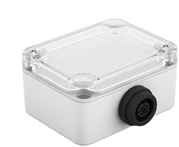
Container identification is fully automatic. The system uses special RFID antennas installed on garbage truck lifters to automatically detect RFID transponders fitted on the bins and containers. No additional actions by the workers are required and the system does not affect the usual work processes.

The use of the bin identification system enables implementation of PAYT waste collection service service billing system – according to volume and number of collections or weight.

The data about waste bin emptying is submitted to the server only if the system's sensors confirm that the bin was on the lifter in the emptying position.

All data from the system on the vehicle is submitted to the EcoMobile cloud app wirelessly (GPRS) in real time and then directly forwarded to existing billing software (ERP)


Installed inside a vehicle’s cockpit, the central computer controls overall operation of the entire system and enables storing, processing and wireless data transfer (GPRS) in real time. It receives data from the controller unit that is connected with antennas, sensors, and push button boxes for irregularity reporting.

Installed in the rear side of the superstructure, the controller unit communicates with other system components via CAN bus, aggregates and relays all collected data to the Central computer. The unit’s housing and terminal plug-in connectors have IP67 protection level.

The antennas are installed on the hydraulic lifter and they are used for automatic reading of RFID transponders fitted on waste bins and containers. They are integrated in robust housings made of highly resistant industrial plastic and can be installed on all types of waste collection vehicles.

Alerts the workers with signals corresponding to particular process (successful/failed reading, irregularity reports, blacklisted user).

Waste bin identification is fully automatic. The system uses special RFID antennas installed on garbage truck lifters to automatically detect RFID transponders fitted on the bins and containers. No additional actions by the workers are required and the system does not affect the usual work processes.

The signalling equipment installed on the vehicle provides simple information to the workers about the RFID transponder reading, either by the system's antennas or peripheral devices and reported irregularities. It also notifies the waste workers in case of missing or non-functional RFID tags, as well as blacklisted users.

The system automatically detects bins without RFID transponders and instantly allerts the workers.

The sensors detect the presence of bins on the lifter, i.e. the presence of RFID tags on the bins. The second stage of verification is done using sensors that detect when the lifter with the bins on it is in the emptying position. This finally confirms that the identified bin has been emptied. The data is submitted to the server only after receiving confirmation that the identified bin has been emptied.

The system enables wireless transfer of blacklisted user data from the billing software (ERP) to the EcoMobile central computer in the vehicle. In case the owner of the bin about to be emptied is blacklisted, the system automatically allert the workers with corresponding audible and visual signals.

The system records GPS coordinates for each bin emptying and sends the data to the EcoMobile cloud application where the emptyings can be seen on GIS map

EcoMobile system supports connection and data transfer from a mobile weighing system installed on the vehicle. The bin identification and weighing data are submitted to the cloud application in real time.

By pressing the adequate button on one of two push button boxes installed in the rear side of the superstructure, the workers can electronically report up to 3 different irregularities (e.g., overfilled bin/container or inappropriate waste inside a bin/container).

EcoMobile central computer's integrated GPRS module enables wirelless data transfer in real time (emptied waste containers, reported irregularities, vehicle tracking, etc.).

After the data is submitted and processed on the EcoMobile server, it is directly exported to the clients existing billing software.

Control unit installed in the vehicle has an integrated RF communication module for wireless data transfer from the peripheral components (RFID access control, handheld readers, etc.) within a 50-metre radius.

GPS tracking provides precise information regarding the current status and location of waste collection vehicles, as well as detailed records of all driving routes.

Central computer that is located in the vehicle cabin is also used for electronic login/log off for the workers which enables tracking of their work hours. The workers use RFID cards or tags to easily login or log off.

All recorded data is saved to central computer’s safety memory, where it remains stored for two years, regardless of having been successfully submitted to the server. In case of breakdowns or accidents, the data can be transferred manually using a USB stick or an SD card.

The communication (data transfer) between the components of the EcoMobile system is carried out through CAN communication protocol that ensures extremely high transfer speeds, as well as maximum level of dana security and consistency.

The central computer has an integrated OTA (Over-the-air programming) electronics that enables wireless upgrade of operating software.